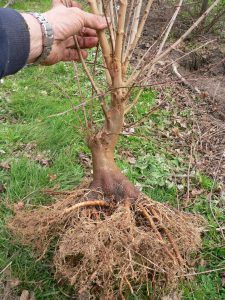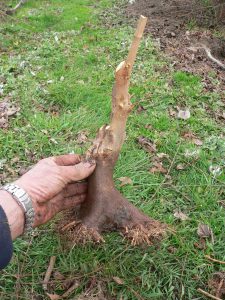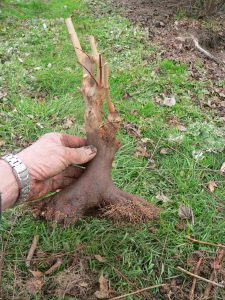It is winter at Shibui Bonsai and time to dig the trees in the grow beds.
I’m now digging most deciduous trees every year. This will slightly reduce trunk thickening but that should be more than made up for in better nebari and better nebari seems to produce vastly improved basal flare, particularly on trident maples.
 This trident has been dug and replanted each year for 3 years. The trunk is now around 5cm diameter.
This trident has been dug and replanted each year for 3 years. The trunk is now around 5cm diameter.
 After shaking off as much soil as possible the roots are cut back to give a manageable root ball.
After shaking off as much soil as possible the roots are cut back to give a manageable root ball.
Branches and leaders are then cut back to make the tree easier to handle before final assessment.
Final root pruning aims to further ramify lateral surface roots and completely remove roots that point downward. There is no point in producing a great bonsai if you can’t fit it into a bonsai pot at some stage in the future. Aggressive root reduction produces plenty of fine feeder roots on a compact root system.
Pruning the top regularly produces a number of leaders. These give opportunity to prune to leave an attractive trunk line with good taper while leaving several smaller scars that should heal faster than a single larger one.
 Looking at the trunk from all sides and considering roots, trunk and branches I pick one or 2 possible trunk lines and remove excess growth. plenty of new buds will grow from the remaining trunks and near many of the cuts so there will be ample options to grow new branches and leaders. The other side of this tree may also yield a good front for a future bonsai so both options are left on at this stage.
Looking at the trunk from all sides and considering roots, trunk and branches I pick one or 2 possible trunk lines and remove excess growth. plenty of new buds will grow from the remaining trunks and near many of the cuts so there will be ample options to grow new branches and leaders. The other side of this tree may also yield a good front for a future bonsai so both options are left on at this stage.
I feel it is important at this stage to make sure all long internodes are removed. New shoots cannot grow from between the nodes so leaving long internodes on the tree at this stage will produce trunks and branches with bare areas lacking ramification. You may be able to get away with this on larger bonsai but such defects really show up on smaller sized trees.
